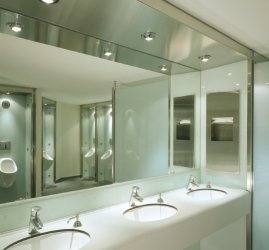Paul Renyard talks to Anne-Marie Clark about how simple changes in the day-to-day running of a theatre can have a big impact on the theatres relationship with the environment.

Has the theatre industry risen to the green challenge or is it sadly lagging behind in doing its bit for the environment? Well, maybe its not actually as far behind as people may think. Along with many theatres around the country, the Theatre Royal Plymouth has taken big steps to reduce its carbon emissions by incorporating environmentally friendly solutions into the day-to-day running of the theatre. But is an environmentally friendly approach to the detriment of the theatrical experience? It seems not. Changes have been made to key areas in the running of the theatre lighting, heating and water usage with no obvious impact on the overall aesthetics of the building but with considerable impact on the theatres relationship with the environment.
With budgetary restraints typical of most theatres, the Theatre Royals philosophy is to start with the easy wins and to make a valid business case for any changes: what happens if we change that light for something more energy efficient? And what effect will it have on the bottom line? Replacing a standard lamp with an LED or a low energy fluorescent may not seem like a very big step towards saving our planet, but with more than 6,000 lamps in the building (of which 30% are changed annually), small changes like this make a big difference. LED lamps use almost 90% less electricity than standard lamps and can last years, instead of weeks or even days. There may be a greater up-front cost, but over the long-term, financially, they make commercial and ethical sense.
Built in the early 1980s, the Theatre Royal was designed and built at a time when, if you were cold, you turned up the gas. If the heating needed to be increased in one area of the building, it went up in the rest of the building too. Now, the Theatre Royal can boast a gas consumption that is down by an impressive 25%. How was this achieved? By replacing a 750kw boiler that was only 50% efficient with two Zenex® Blades (each powered by a 50kw condensing boiler operating at over 98% efficiency) and by introducing a computerised control system that divides the building into zones. This allows the heating to be individually controlled in each area. Not only can the computerised system be programmed to optimise when the boilers come on, but it also controls when air conditioning is available. For example, if the auditorium is too warm and the outside temperature is cooler, air is dragged in from outside to reduce the temperature indoors. Only if the air temperature outside is too warm will the air conditioning automatically cut in.
Water consumption has also been a key focus area. Hippos have been fitted to every toilet back of house to help conserve water in the cistern. Every time a toilet is flushed, the Hippo saves 3 litres of water. Urinals are on sensors so they flush only when they need to, not routinely every 1015 minutes, 24 hours a day. Percussion taps have been fitted on sinks to further reduce water usage. Water consumption has been reduced by a third since these simple, yet effective changes, have been made.
The efforts of the Theatre Royal havent gone unnoticed either: the theatre has been held up as a model of good practical environmental management for other businesses in Plymouth. Lagging behind? It seems not. Leading the way? Well, we are in Plymouth.
Paul Renyard is Director of Corporate Services and Anne-Marie Clark is Press Officer at the Theatre Royal Plymouth.
e: paul.renyard@theatreroyal.com; {anne-marie.clark @theatreroyal.com}



